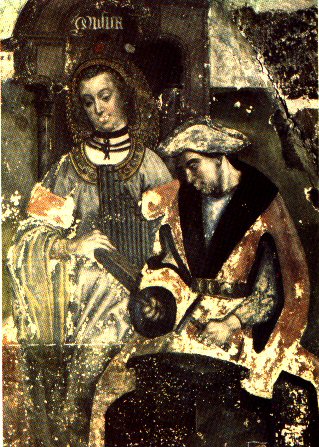Josquin Desprez was one of many northern European composers whose careers flourished in Southern Europe; after growing up in Flanders, he travelled to Italy and became the leading composer of the early sixteenth century. In his music we begin to see a true Late Renaissance sensibility grounded in humanism.
With the development of printing and the rediscovery of many Classical texts in fifteenth century Italy, an entirely new collection of Latin and Greek literature, grammar, rhetoric and dialectic was able to be explored. Some texts caused consternation among Chruch fathers who had difficulty reconciling the tenets of Christianity with the ideas of antiquity.
In music, the influence of humanism was seen in the new approach to text setting, in which the text's integrity was paramount, and its rhythms, accents and structure could drive the musical phrase. Whereas before a word such as "Kyrie" might be attenuated over a long melisma, composers of the Late Renaissance would keep the phrase short and more syllabic, perhaps repeating the words for rhetorical emphasis.
Nonetheless, Early Renaissance procedures did not disappear overnight and compostions could remain couched in artifice for a generation or more. Josquin somehow managed to straddle these stylistic boundaires, writing something modern in which the music reflected and enhanced the text in one composition, while in another he might writing something utterly complex in which tricks were played with the cantus firmus and riddles about people and society were hidden within the music.
When Josquin was commissioned to write a mass for Duke Hercules of Ferrara, he proceeded to make an elaborate musical riddle as his cantus firmus. He took the vowels of Hercules name and matched them with the syllables of the scale: ut, re, mi, fa, sol, la ti (at the time "do" was known as "ut"). Using this method, Hercules dux Ferrariae became re, ut, re, ut, re, fa, mi, re: a particularly useful cantus firmus for the entire Mass. It is because of Josquin's unique tribute that anyone remembers this obscure Duke.
Late Renaissance style is characterized by an appreciation of the text. Instead of long shapeless melodies interacting obliquely if at all; composers of the late Renaissance began to work with more free, fluid, long-breathed melodic lines that interacted in a more democratic way. Imitation begins to be used between voices and each singer's melody becomes less rangy and more tied to the text.
This composition is very transitional in style. While early Renaissance cantus firmus techniques are used, late Renaissance ideas of text setting and imitation are also prevalent. There is even a shift from the idea of cantus firmus as scaffolding on which polyphonic voices are constructed to cantus firmus as "soul" and pervasive throughout the composition. In works that use the cantus firmus as a soul, the melody is deconstructed and remade as a repository of motives for the vocal parts, rather than a scaffolding.

Josquin Desprez (1455-1521)